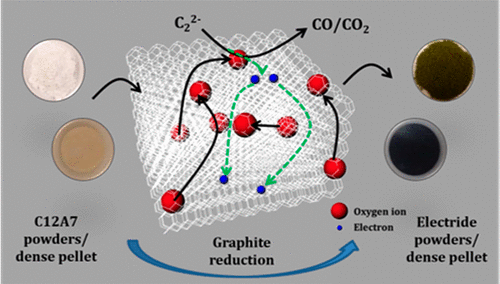当前位置:
X-MOL 学术
›
Inorg. Chem.
›
论文详情
Our official English website, www.x-mol.net, welcomes your feedback! (Note: you will need to create a separate account there.)
Simple and Efficient Fabrication of Mayenite Electrides from a Solution-Derived Precursor
Inorganic Chemistry ( IF 4.6 ) Pub Date : 2017-09-19 00:00:00 , DOI: 10.1021/acs.inorgchem.7b01655 Dong Jiang 1 , Zeyu Zhao 1 , Shenglong Mu 1 , Vincent Phaneuf 1 , Jianhua Tong 1
Inorganic Chemistry ( IF 4.6 ) Pub Date : 2017-09-19 00:00:00 , DOI: 10.1021/acs.inorgchem.7b01655 Dong Jiang 1 , Zeyu Zhao 1 , Shenglong Mu 1 , Vincent Phaneuf 1 , Jianhua Tong 1
Affiliation

|
Mayenite (12CaO·7Al2O3, C12A7) electride with an anti-zeolite nanoporous structure has attracted intense attention due to its versatile promising application potentials. However, the synthesis difficulty because of extremely harsh conditions (e.g., reduction in sealed calcium or titanium vapor) significantly obstructs its realistic applications. In this work, we employed a simple, efficient, and cost-effective route for synthesizing mayenite electrides (C12A7:e–) in both powder and dense ceramic. C12A7:e– powders with efficient electron doping (3.5 × 1020 cm–3) were obtained via simple graphite reduction of a novel mixture precursor of CaAl2O4 (CA) and Ca3Al2O6 (C3A) derived from a modified Pechini method. The structural evolution during the electride formation was investigated, and it was found that reduction below 1300 °C induced the formation of Ca5Al6O14 (C5A3), while reduction above 1400 °C helped retain the mayenite structure. Fully dense C12A7:e– ceramics were also fabricated via graphite reduction of presintered pellets with a relative density of 97.9% starting from the CA+C3A mixture. Careful studies improved the mechanism cognition of graphite treatment that the electrons injection was probably initiated by surface reduction with involatile C species (e.g., C22–) rather than previously proposed CO, during which the mixed conduction of oxygen ions and electrons played an important role. Furthermore, the stability of C12A7:e– in water as well as in the presence of moisture was discussed. These results not only suggest a novel precursor for fabricating high-quality mayenite electrides but also provide in-depth insights into the stability of the mayenite structure toward practical applications.
中文翻译:

从溶液衍生的前驱体简单高效地制备马氏体电极
具有抗沸石纳米多孔结构的锰铁矿(12CaO·7Al 2 O 3,C12A7)由于其广泛的应用前景而备受关注。但是,由于极端苛刻的条件(例如,密封钙或钛蒸气的减少)而导致的合成困难极大地阻碍了其实际应用。在这项工作中,我们采用了一种简单,高效且具有成本效益的方法来合成粉末和致密陶瓷中的钙铝石驻极体(C12A7:e –)。C12A7:e –有效的电子掺杂粉末(3.5×10 20 cm –3)通过对新的CaAl 2 O 4混合前体进行简单的石墨还原得到。(CA)和Ca 3 Al 2 O 6(C3A)源自改良的Pechini方法。研究了驻极体形成过程中的结构演变,发现在1300°C以下还原会诱导形成Ca 5 Al 6 O 14(C5A3),而在1400°C以上还原则有助于保持钙铝石结构。完全致密的C12A7:e –陶瓷也通过从CA + C3A混合物开始以石墨还原预烧结的球团制成,相对密度为97.9%。仔细的研究改善了石墨处理的机理认识,即电子注入可能是由具有不稳定C物种(例如C 2)的表面还原引发的。2 –)而不是先前提出的CO,在此期间,氧离子和电子的混合传导起着重要作用。此外,C12A7的稳定性:电子-讨论在水中以及在水分存在。这些结果不仅暗示了用于制造高质量钙铝石驻极体的新型前驱物,而且还提供了深入了解钙铝石结构在实际应用中的稳定性的见解。
更新日期:2017-09-19
中文翻译:

从溶液衍生的前驱体简单高效地制备马氏体电极
具有抗沸石纳米多孔结构的锰铁矿(12CaO·7Al 2 O 3,C12A7)由于其广泛的应用前景而备受关注。但是,由于极端苛刻的条件(例如,密封钙或钛蒸气的减少)而导致的合成困难极大地阻碍了其实际应用。在这项工作中,我们采用了一种简单,高效且具有成本效益的方法来合成粉末和致密陶瓷中的钙铝石驻极体(C12A7:e –)。C12A7:e –有效的电子掺杂粉末(3.5×10 20 cm –3)通过对新的CaAl 2 O 4混合前体进行简单的石墨还原得到。(CA)和Ca 3 Al 2 O 6(C3A)源自改良的Pechini方法。研究了驻极体形成过程中的结构演变,发现在1300°C以下还原会诱导形成Ca 5 Al 6 O 14(C5A3),而在1400°C以上还原则有助于保持钙铝石结构。完全致密的C12A7:e –陶瓷也通过从CA + C3A混合物开始以石墨还原预烧结的球团制成,相对密度为97.9%。仔细的研究改善了石墨处理的机理认识,即电子注入可能是由具有不稳定C物种(例如C 2)的表面还原引发的。2 –)而不是先前提出的CO,在此期间,氧离子和电子的混合传导起着重要作用。此外,C12A7的稳定性:电子-讨论在水中以及在水分存在。这些结果不仅暗示了用于制造高质量钙铝石驻极体的新型前驱物,而且还提供了深入了解钙铝石结构在实际应用中的稳定性的见解。



























 京公网安备 11010802027423号
京公网安备 11010802027423号